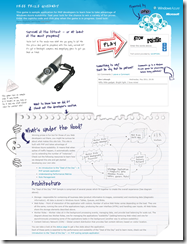New SDK and Sample Kit demonstrates how to leverage the scalability of Windows Azure with PHP
From the floor of the PHP Tek Conference in Chicago, with my colleague Peter Laudati, we’re excited to announce the availability of the Windows Azure SDK for PHP version 3.0. This Open Source SDK gives PHP developers a “speed dial” library to take full advantage of Windows Azure’s coolest features. On top of many improvements and bug fixes for this version (see the list from Maarten Balliauw’s preview), we’re particularly excited about the new service management possibilities and the new logging infrastructure.
Beyond the new features, we also feel that version 3.0 of this SDK marks an important milestone because we’re not only starting to witness real world deployment, but also we’re seeing more people joining the project and contributing. We’ve been talking a lot to Maarten Balliauw from RealDolmen who is the lead developer on this open source project and he also shares the same sentiment: “It’s interesting to see the Windows Azure SDK for PHP mature: people are willing to contribute to it and incorporate their experience with the SDK and the platform. ”
The most compute intensive part of Facebook app www.hotelpeeps.com is powered by PHP on Windows Azure
 My colleague Todi Pruteanu from Microsoft Romania worked with Lucian Daia and Alexandru Lapusan from Zitec to help them get started with PHP on Windows Azure. The result is impressive. The most compute intensive part of the Hotel Peeps Facebook application is now running on Windows Azure, using the SDK for PHP, as well as SQL Azure. Read the interview of Alexandru to get the details on what and how they did it (you can also check out the case study here). I like this quote from the interview: “HotelPeeps Trends running on the Windows Azure platform is the epitome of interoperability. Some people think that a PHP application running on Microsoft infrastructure is science fiction, but that’s not the case. ”
My colleague Todi Pruteanu from Microsoft Romania worked with Lucian Daia and Alexandru Lapusan from Zitec to help them get started with PHP on Windows Azure. The result is impressive. The most compute intensive part of the Hotel Peeps Facebook application is now running on Windows Azure, using the SDK for PHP, as well as SQL Azure. Read the interview of Alexandru to get the details on what and how they did it (you can also check out the case study here). I like this quote from the interview: “HotelPeeps Trends running on the Windows Azure platform is the epitome of interoperability. Some people think that a PHP application running on Microsoft infrastructure is science fiction, but that’s not the case. ”
Another interesting aspect is also the subsequent contribution by Zitec of an advanced “logging” component to the Windows Azure SDK for PHP. This new component provides the possibility of storing logs from multiple instances in a centralized location, namely Azure Tables.
More contributions from the community
As the SDK gets more widely adopted, there is an exciting trend toward more community involvement. For example, Damien Tournoud from the CommerceGuys who is working on developing the Drupal integration module for Windows Azure, recently contributed a patch fixing bugs related to inconsistencies in URL-encoding of parameters in the HTTP_Client library. As we continue to improve the SDK to ensure great interoperability with popular applications like WordPress, Drupal and Joomla! we look forward to engagement more deeply with those communities to make the experience even better.
New! Windows Azure Sample Kit for PHP
Today we are also announcing the Windows Azure Sample Kit for PHP. It is a new project hosted on github that will be the primary repository for all sample php code / apps that developers can use to learn how to take advantage of the various features of Windows Azure in php. Today we are releasing two samples to the repository: the Guestbook application (example of how to use the Windows Azure storage objects – blobs, queues and tables as well as a simple web/worker pattern) and “Deal of the Day” (more on this one later). We look forward to feedback on the samples and I am also hoping to see some forks and new samples coming from the community!
New features to easily manage auto-scaling of applications on Windows Azure
As I mentioned the version 3.0 of the Windows Azure SDK for PHP includes a new “service management” library, which provides easy ways to monitor the activity of your running instances (Windows Azure web roles & workers roles virtual machines), and to start/stop automatically instances based on usage. Then it becomes easy for you to decide which parameters (CPU, bandwidth, # of connections, etc.) and thresholds to use to scale up and down, and maintain the optimum quality of service for your web applications.
The scenario is simple: let’s say you are running an e-commerce site and you want to run daily promotions to get rid of overstocked items. So you’re going to offer crazy deals every day starting at 8am, each deal being advertised to your subscribers by an email blast. You will have to be ready ready to absorb a major spike in traffic, but the exact time is difficult to predict as the news of the deal may take some time to travel through twitter. When the traffic does materialize, you want the site to run & scale independently – providing service assurance but also minimizing your costs (by shutting down unnecessary capacity as loads go down). This is the scenario for the “Deal of the Day” sample application.
What’s the “Deal of the Day” (DotD) sample app and what to expect?
 Deal of the Day (DotD) is a sample application written in PHP to show how to utilize Windows Azure’s scalability features from within PHP. We’ve kept is simple and built it in a way that’s easy to deconstruct and learn from.
Deal of the Day (DotD) is a sample application written in PHP to show how to utilize Windows Azure’s scalability features from within PHP. We’ve kept is simple and built it in a way that’s easy to deconstruct and learn from.
As a sample application, DotD did not undergo extensive testing, nor does the code include all the required error catching, security verifications and so on, that an application designed for real production would require. So, do expect glitches. And if you do witness issues, send us a screenshot showing error messages with a description. I’ll get a prize to the first 100 bug trackers!
However, to give you an opportunity to see the sample application working, we’ve decided to deploy a live version on Windows Azure to let you test it for real and give the chance to win actual fun prizes! (and sorry for our friends outside of USA, but prizes can be shipped only to a US address ![]() )
)
Wanna play? Just go this way: http://dealoftheday.cloudapp.net/
Looking for the code, just get it on GitHub here: https://github.com/Interop-Bridges/Windows-Azure-Sample-Kit-4-PHP/tree/master/dealoftheday_sample
Architecture of the DotD sample app
 The DotD sample app is comprised of several pieces which fit together to create the overall experience:
The DotD sample app is comprised of several pieces which fit together to create the overall experience:
- Storage –responsible for containing all business data (product information & images, comments) and monitoring data (diagnostic information). All data is stored in Windows Azure Tables, Queues, and Blobs.
- Web Roles – Point of interaction of the application with visitors. Number of active Web Roles varies depending on the load. They are all the same, running the core of the applications logic, producing the user interface (HTML) and handling user inputs. All Web Roles share the storage elements described above.
- Worker Roles – Worker roles sit in the background processing events, managing data, and provide load balancing for scale out. The diagram shows two Worker Roles, one for managing the applications “scalability” (adding/removing Web roles) and one for asynchronously processing some of the applications tasks in the background (another way to achieve scalability)
- Content Delivery Network (CDN) – Global content distribution that provides fast content delivery based on visitor location.
Each of these parts is essential to the performance and scalability of DotD and for more details I invite you to read this introduction article, and then to dig deeper by reading part I (Performance Metrics) and Part II (Role Management) of our “Scaling PHP applications on Windows Azure” series. We will expand the series with additional in depth articles, the next one will be around monitoring the performance of your app.
We look forward to your feedback on the SDK and the Sample Kit. Once again the URL is https://github.com/Interop-Bridges/Windows-Azure-Sample-Kit-4-PHP
Cheers!
Craig Kitterman
Twitter: Follow @craigkitterman